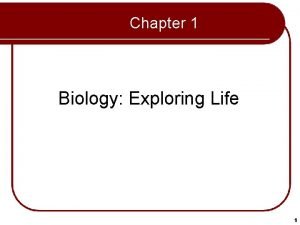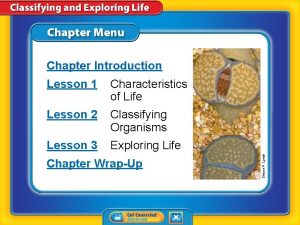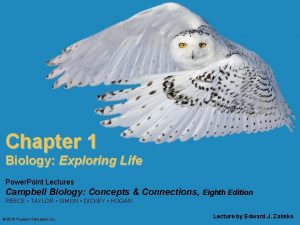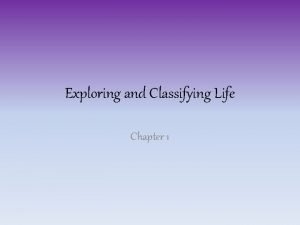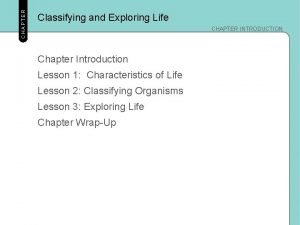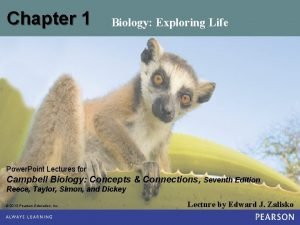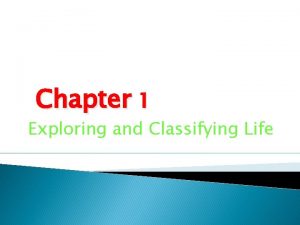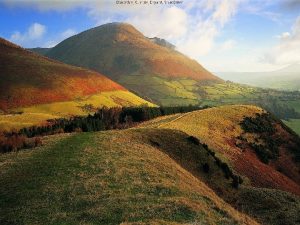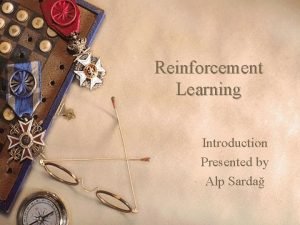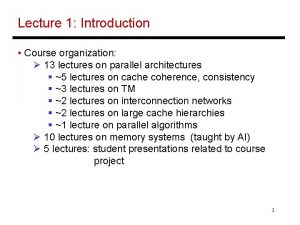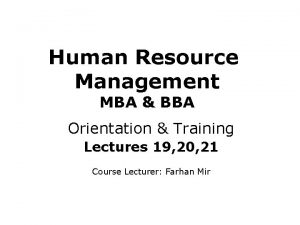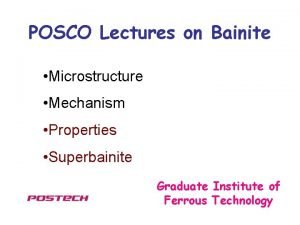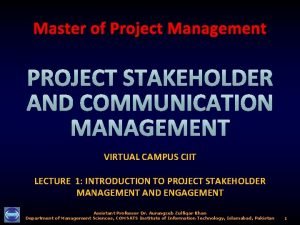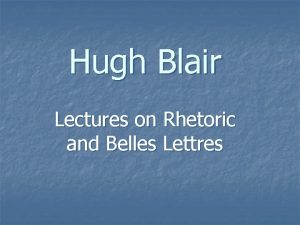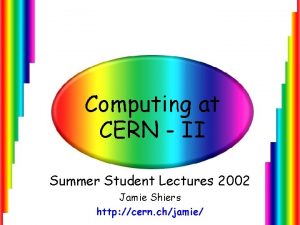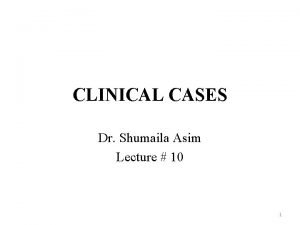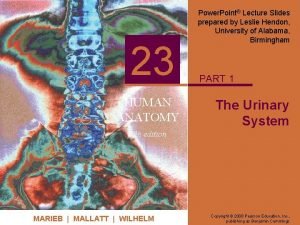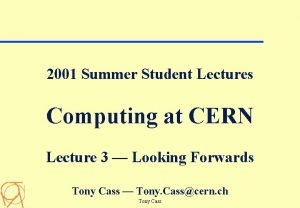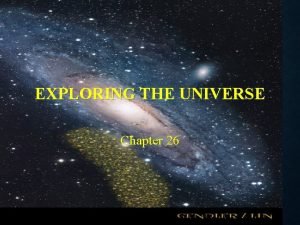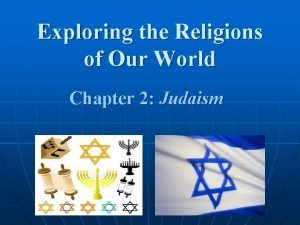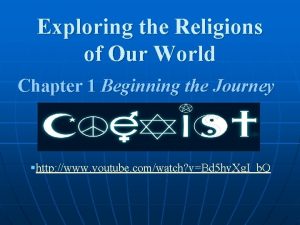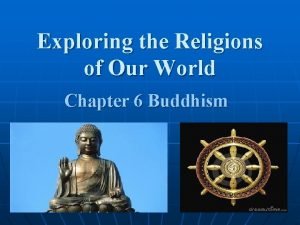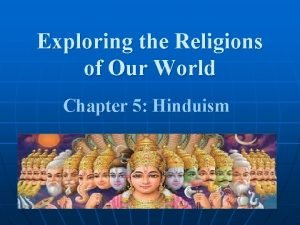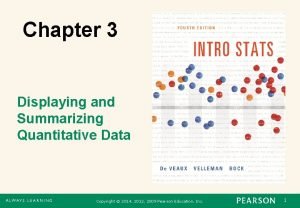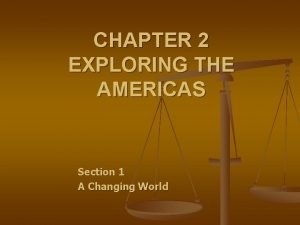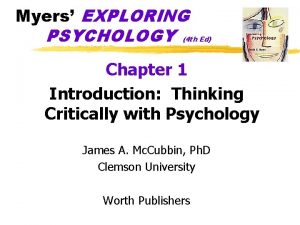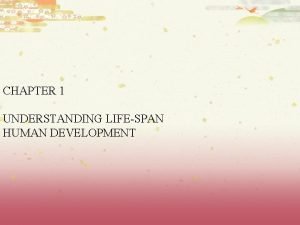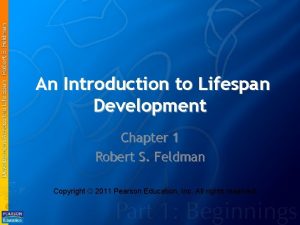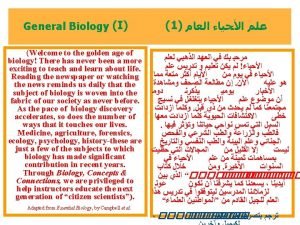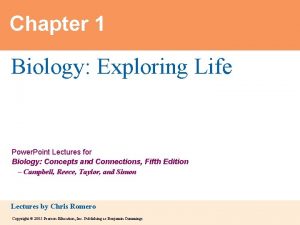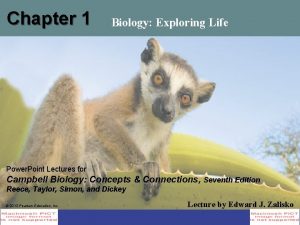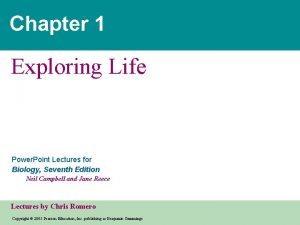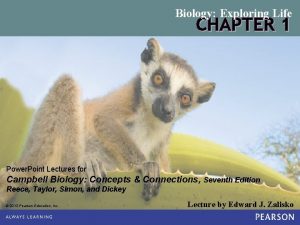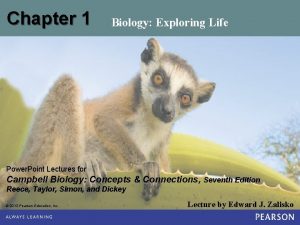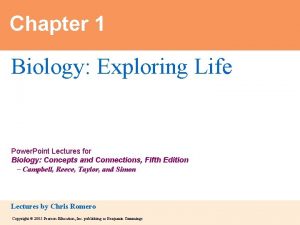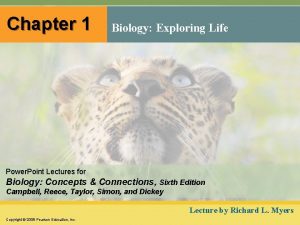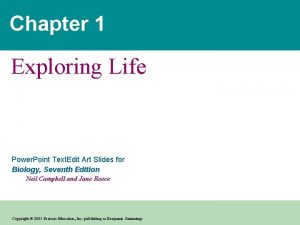Chapter 1 Exploring Life Power Point Lectures for






























































































- Slides: 94

Chapter 1 Exploring Life Power. Point Lectures for Biology, Seventh Edition Neil Campbell and Jane Reece Lectures by Chris Romero Copyright © 2005 Pearson Education, Inc. publishing as Benjamin Cummings

• Overview: Biology’s Most Exciting Era • Biology is the scientific study of life • Biologists are moving closer to understanding: – How a single cell develops into an organism – How plants convert sunlight to chemical energy – How the human mind works – How living things interact in communities – How life’s diversity evolved from the first microbes Copyright © 2005 Pearson Education, Inc. publishing as Benjamin Cummings

Copyright © 2005 Pearson Education, Inc. publishing as Benjamin Cummings

• Life’s basic characteristic is a high degree of order • Each level of biological organization has emergent properties Video: Seahorse Camouflage Copyright © 2005 Pearson Education, Inc. publishing as Benjamin Cummings

Copyright © 2005 Pearson Education, Inc. publishing as Benjamin Cummings

• Concept 1. 1: Biologists explore life from the microscopic to the global scale • The study of life extends from molecules and cells to the entire living planet • Biological organization is based on a hierarchy of structural levels Copyright © 2005 Pearson Education, Inc. publishing as Benjamin Cummings

A Hierarchy of Biological Organization 1. Biosphere: all environments on Earth 2. Ecosystem: all living and nonliving things in a particular area 3. Community: all organisms in an ecosystem 4. Population: all individuals of a species in a particular area 5. Organism: an individual living thing Copyright © 2005 Pearson Education, Inc. publishing as Benjamin Cummings

A Hierarchy of Biological Organization (continued) 6. Organ and organ systems: specialized body parts made up of tissues 7. Tissue: a group of similar cells 8. Cell: life’s fundamental unit of structure and function 9. Organelle: a structural component of a cell 10. Molecule: a chemical structure consisting of atoms Copyright © 2005 Pearson Education, Inc. publishing as Benjamin Cummings

The biosphere Ecosystems Organelles 1 µm Cells Atoms 10 µm Communities Molecules Tissues Populations Organisms 50 µm Organs and organ systems

A Closer Look at Ecosystems • Each organism interacts with its environment • Both organism and environment affect each other Copyright © 2005 Pearson Education, Inc. publishing as Benjamin Cummings

Ecosystem Dynamics • The dynamics of an ecosystem include two major processes: – Cycling of nutrients, in which materials acquired by plants eventually return to the soil – The flow of energy from sunlight to producers to consumers Copyright © 2005 Pearson Education, Inc. publishing as Benjamin Cummings

Energy Conversion • Activities of life require work • Work depends on sources of energy • Energy exchange between an organism and environment often involves energy transformations • In transformations, some energy is lost as heat • Energy flows through an ecosystem, usually entering as light and exiting as heat Copyright © 2005 Pearson Education, Inc. publishing as Benjamin Cummings

LE 1 -4 Sunlight Ecosystem Producers (plants and other photosynthetic organisms) Heat Chemical energy Consumers (including animals) Heat

A Closer Look at Cells • The cell is the lowest level of organization that can perform all activities of life • The ability of cells to divide is the basis of all reproduction, growth, and repair of multicellular organisms Copyright © 2005 Pearson Education, Inc. publishing as Benjamin Cummings

LE 1 -5 25 µm

The Cell’s Heritable Information • Cells contain DNA, the heritable information that directs the cell’s activities • DNA is the substance of genes • Genes are the units of inheritance that transmit information from parents to offspring Copyright © 2005 Pearson Education, Inc. publishing as Benjamin Cummings

LE 1 -6 Sperm cell Nuclei containing DNA Egg cell Fertilized egg with DNA from both parents Embryo’s cells With copies of inherited DNA Offspring with traits inherited from both parents

• Each DNA molecule is made up of two long chains arranged in a double helix • Each link of a chain is one of four kinds of chemical building blocks called nucleotides Copyright © 2005 Pearson Education, Inc. publishing as Benjamin Cummings

LE 1 -7 Nucleus DNA Nucleotide Cell DNA double helix Single strand of DNA

Two Main Forms of Cells • Characteristics shared by all cells: – Enclosed by a membrane – Use DNA as genetic information • Two main forms of cells: – Eukaryotic: divided into organelles; DNA in nucleus – Prokaryotic: lack organelles; DNA not separated in a nucleus Copyright © 2005 Pearson Education, Inc. publishing as Benjamin Cummings

LE 1 -8 EUKARYOTIC CELL PROKARYOTIC CELL DNA (no nucleus) Membrane Cytoplasm Organelles Nucleus (contains DNA) 1 µm

• Concept 1. 2: Biological systems are much more than the sum of their parts • A system is a combination of components that form a more complex organization • Cells, organisms, and ecosystems are some examples of biological systems Copyright © 2005 Pearson Education, Inc. publishing as Benjamin Cummings

The Emergent Properties of Systems • Emergent properties result from arrangements and interactions within systems • New properties emerge with each step upward in the hierarchy of biological order Copyright © 2005 Pearson Education, Inc. publishing as Benjamin Cummings

The Power and Limitations of Reductionism • Reductionism is reducing complex systems to simpler components that are easier to study • The studies of DNA structure and the Human Genome Project are examples of reductionism Copyright © 2005 Pearson Education, Inc. publishing as Benjamin Cummings

Copyright © 2005 Pearson Education, Inc. publishing as Benjamin Cummings

Systems Biology • Systems biology seeks to create models of the dynamic behavior of whole biological systems • An example is a systems map of interactions between proteins in a fruit fly cell • Such models may predict how a change in one part of a system will affect the rest of the system Copyright © 2005 Pearson Education, Inc. publishing as Benjamin Cummings

LE 1 -10 Outer membrane and cell surface CELL Cytoplasm Nucleus

• Systems biology uses three key research developments: – High-throughput technology: methods to generate large data sets rapidly – Bioinformatics: using computers and software to process and integrate large data sets – Interdisciplinary research teams Copyright © 2005 Pearson Education, Inc. publishing as Benjamin Cummings

Feedback Regulation in Biological Systems • Regulatory systems ensure a dynamic balance in living systems • Chemical processes are catalyzed (accelerated) by enzymes • Many biological processes are self-regulating: the product regulates the process itself Copyright © 2005 Pearson Education, Inc. publishing as Benjamin Cummings

• In negative feedback, the accumulation of a product slows down the process itself • In positive feedback (less common), the product speeds up its own production Animation: Negative Feedback Copyright © 2005 Pearson Education, Inc. publishing as Benjamin Cummings Animation: Positive Feedback

LE 1 -11 A Negative feedback Enzyme 1 B A Enzyme 1 B Enzyme 2 C C Enzyme 3 D D D

LE 1 -12 W W Enzyme 4 X X Positive feedback Enzyme 5 Y Y Enzyme 6 Z Z Z Z Z

• Concept 1. 3: Biologists explore life across its great diversity of species • Biologists have named about 1. 8 million species • Estimates of total species range from 10 million to over 200 million Copyright © 2005 Pearson Education, Inc. publishing as Benjamin Cummings

Copyright © 2005 Pearson Education, Inc. publishing as Benjamin Cummings

Grouping Species: The Basic Idea • Taxonomy is the branch of biology that names and classifies species into a hierarchical order • Kingdoms and domains are the broadest units of classification Copyright © 2005 Pearson Education, Inc. publishing as Benjamin Cummings

LE 1 -14 Species Genus Family Order Class Phylum Kingdom Domain Ursus americanus (American black bear) Ursus Ursidae Carnivora Mammalia Chordata Animalia Eukarya

The Three Domains of Life • At the highest level, life is classified into three domains: – Bacteria (prokaryotes) – Archaea (prokaryotes) – Eukarya (eukaryotes) Eukaryotes include protists and the kingdoms Plantae, Fungi, and Animalia Copyright © 2005 Pearson Education, Inc. publishing as Benjamin Cummings

LE 1 -15 Bacteria Archaea 4 µm 0. 5 µm Protists Kingdom Fungi 100 µm Kingdom Plantae Kingdom Animalia

Unity in the Diversity of Life • Underlying life’s diversity is a striking unity, especially at lower levels of organization • In eukaryotes, unity is evident in details of cell structure Copyright © 2005 Pearson Education, Inc. publishing as Benjamin Cummings

LE 1 -16 a 15 µm Cilia of Paramecium Cilia of windpipe cells

LE 1 -16 b 0. 1 µm Cilia of Paramecium Cross section of cilium, as viewed with an electron microscope Cilia of windpipe cells

• Concept 1. 4: Evolution accounts for life’s unity and diversity • The history of life is a saga of a changing Earth billions of years old Copyright © 2005 Pearson Education, Inc. publishing as Benjamin Cummings

Copyright © 2005 Pearson Education, Inc. publishing as Benjamin Cummings

• The evolutionary view of life came into sharp focus in 1859, when Charles Darwin published On the Origin of Species by Natural Selection • “Darwinism” became almost synonymous with the concept of evolution Copyright © 2005 Pearson Education, Inc. publishing as Benjamin Cummings

Copyright © 2005 Pearson Education, Inc. publishing as Benjamin Cummings

• The Origin of Species articulated two main points: – Descent with modification (the view that contemporary species arose from a succession of ancestors) – Natural selection (a proposed mechanism for descent with modification) • Some examples of descent with modification are unity and diversity in the orchid family Copyright © 2005 Pearson Education, Inc. publishing as Benjamin Cummings

Copyright © 2005 Pearson Education, Inc. publishing as Benjamin Cummings

Natural Selection • Darwin inferred natural selection by connecting two observations: – Observation: Individual variation in heritable traits – Observation: Overpopulation and competition – Inference: Unequal reproductive success – Inference: Evolutionary adaptation Copyright © 2005 Pearson Education, Inc. publishing as Benjamin Cummings

LE 1 -20 Population of organisms Overproduction and competition Hereditary variations Differences in reproductive success Evolution of adaptations in the population

• Natural selection can “edit” a population’s heritable variations • An example is the effect of birds preying on a beetle population Copyright © 2005 Pearson Education, Inc. publishing as Benjamin Cummings

LE 1 -21 Population with varied inherited traits Elimination of individuals with certain traits Reproduction of survivors Increasing frequency of traits that enhance survival and reproductive success

• Natural selection is often evident in adaptations of organisms to their way of life and environment • Bat wings are an example of adaptation Video: Soaring Hawk Copyright © 2005 Pearson Education, Inc. publishing as Benjamin Cummings

Copyright © 2005 Pearson Education, Inc. publishing as Benjamin Cummings

The Tree of Life • Many related organisms have similar features adapted for specific ways of life • Such kinships connect life’s unity and diversity to descent with modification • Natural selection eventually produces new species from ancestral species • Biologists often show evolutionary relationships in a treelike diagram [Videos on slide following the figure] Copyright © 2005 Pearson Education, Inc. publishing as Benjamin Cummings

LE 1 -23 Large ground finch Large cactus ground finch Geospiza magnirostris Sharp-beaked ground finch Geospiza conirostris Large tree finch Small ground finch Geospiza fuliginosa Medium ground finch Camarhynchus psittacula Woodpecker finch Geospiza difficilis Cactus ground finch Mangrove finch Geospiza fortis Geospiza scandens Seed eater Cactospiza pallida Medium tree finch Camarhynchus pauper Small tree finch Gray warbler finch Certhidea olivacea Certhidea fusca Camarhynchus parvulus Cactospiza heliobates Cactus flower eaters Green warbler finch Vegetarian finch Seed eaters Platyspiza crassirostris Insect eaters Ground finches Tree finches Bud eater Warbler finches Common ancestor from South American mainland

Video: Albatross Courtship Ritual Video: Blue-footed Boobies Courtship Ritual Video: Galapágos Islands Overview Video Galapágos Marine Iguana Video: Galapágos Sea Lion Video: Galapágos Tortoise Copyright © 2005 Pearson Education, Inc. publishing as Benjamin Cummings

• Concept 1. 5: Biologists use various forms of inquiry to explore life • Inquiry is a search for information and explanation, often focusing on specific questions • The process of science blends two main processes of scientific inquiry: – Discovery science: describing nature – Hypothesis-based science: explaining nature Copyright © 2005 Pearson Education, Inc. publishing as Benjamin Cummings

Discovery Science • Discovery science describes nature through careful observation and data analysis • Examples of discovery science: – understanding cell structure – expanding databases of genomes Copyright © 2005 Pearson Education, Inc. publishing as Benjamin Cummings

Types of Data • Data are recorded observations • Two types of data: – Quantitative data: numerical measurements – Qualitative data: recorded descriptions Copyright © 2005 Pearson Education, Inc. publishing as Benjamin Cummings

Copyright © 2005 Pearson Education, Inc. publishing as Benjamin Cummings

Induction in Discovery Science • Inductive reasoning involves generalizing based on many specific observations Copyright © 2005 Pearson Education, Inc. publishing as Benjamin Cummings

Hypothesis-Based Science • In science, inquiry usually involves proposing and testing hypotheses • Hypotheses are hypothetical explanations Copyright © 2005 Pearson Education, Inc. publishing as Benjamin Cummings

The Role of Hypotheses in Inquiry • In science, a hypothesis is a tentative answer to a well-framed question • A hypothesis is an explanation on trial, making a prediction that can be tested Copyright © 2005 Pearson Education, Inc. publishing as Benjamin Cummings

LE 1 -25 a Observations Question Hypothesis #1: Dead batteries Hypothesis #2: Burnt-out bulb

LE 1 -25 b Hypothesis #1: Dead batteries Hypothesis #2: Burnt-out bulb Prediction: Replacing batteries will fix problem Prediction: Replacing bulb will fix problem Test prediction Test falsifies hypothesis Test does not falsify hypothesis

Deduction: The “If…then” Logic of Hypothesis-Based Science • In deductive reasoning, the logic flows from the general to the specific • If a hypothesis is correct, then we can expect a particular outcome Copyright © 2005 Pearson Education, Inc. publishing as Benjamin Cummings

A Closer Look at Hypotheses in Scientific Inquiry • A scientific hypothesis must have two important qualities: – It must be testable – It must be falsifiable Copyright © 2005 Pearson Education, Inc. publishing as Benjamin Cummings

The Myth of the Scientific Method • The scientific method is an idealized process of inquiry • Very few scientific inquiries adhere rigidly to the “textbook” scientific method Copyright © 2005 Pearson Education, Inc. publishing as Benjamin Cummings

A Case Study in Scientific Inquiry: Investigating Mimicry in Snake Populations • In mimicry, a harmless species resembles a harmful species • An example of mimicry is a stinging honeybee and a nonstinging mimic, a flower fly Copyright © 2005 Pearson Education, Inc. publishing as Benjamin Cummings

LE 1 -26 Flower fly (nonstinging) Honeybee (stinging)

• This case study examines king snakes’ mimicry of poisonous coral snakes • The hypothesis states that mimics benefit when predators mistake them for harmful species • The mimicry hypothesis predicts that predators in non–coral snake areas will attack king snakes more frequently than will predators that live where coral snakes are present Copyright © 2005 Pearson Education, Inc. publishing as Benjamin Cummings

LE 1 -27 Scarlet king snake Key Range of scarlet king snake Range of eastern coral snake North Carolina Eastern coral snake South Carolina Scarlet king snake

Field Experiments with Artificial Snakes • To test this mimicry hypothesis, researchers made hundreds of artificial snakes: – An experimental group resembling king snakes – A control group resembling plain brown snakes • Equal numbers of both types were placed at field sites, including areas without coral snakes • After four weeks, the scientists retrieved the artificial snakes and counted bite or claw marks • The data fit the predictions of the mimicry hypothesis Copyright © 2005 Pearson Education, Inc. publishing as Benjamin Cummings

LE 1 -28 (a) Artificial king snake (b) Artificial brown snake that has been attacked

LE 1 -29 17% In areas where coral snakes were absent, most attacks were on artificial king snakes. 83% Key North Carolina % of attacks on artificial king snakes % of attacks on brown artificial snakes Field site with artificial snakes South Carolina 16% 84% In areas where coral snakes were present, most attacks were on brown artificial snakes.

Designing Controlled Experiments • Scientists do not control the experimental environment by keeping all variables constant • Researchers usually “control” unwanted variables by using control groups to cancel their effects Copyright © 2005 Pearson Education, Inc. publishing as Benjamin Cummings

Limitations of Science • The limitations of science are set by its naturalism – Science seeks natural causes for natural phenomena – Science cannot support or falsify supernatural explanations, which are outside the bounds of science Copyright © 2005 Pearson Education, Inc. publishing as Benjamin Cummings

Theories in Science • A scientific theory is much broader than a hypothesis • A scientific theory is: – broad in scope – general enough to generate new hypotheses – supported by a large body of evidence Copyright © 2005 Pearson Education, Inc. publishing as Benjamin Cummings

Model Building in Science • Models are representations of ideas, structures, or processes • Models may range from lifelike representations to symbolic schematics Copyright © 2005 Pearson Education, Inc. publishing as Benjamin Cummings

LE 1 -30 From body From lungs Right atrium Left atrium Right ventricle Left ventricle To lungs To body

The Culture of Science • Science is an intensely social activity • Both cooperation and competition characterize scientific culture Copyright © 2005 Pearson Education, Inc. publishing as Benjamin Cummings

Copyright © 2005 Pearson Education, Inc. publishing as Benjamin Cummings

Science, Technology, and Society • The goal of science is to understand natural phenomena • Technology applies scientific knowledge for some specific purpose Copyright © 2005 Pearson Education, Inc. publishing as Benjamin Cummings

Copyright © 2005 Pearson Education, Inc. publishing as Benjamin Cummings

• Concept 1. 6: A set of themes connects the concepts of biology • Biology is the science most connected to the humanities and social sciences • Underlying themes provide a framework for understanding biology Copyright © 2005 Pearson Education, Inc. publishing as Benjamin Cummings

Copyright © 2005 Pearson Education, Inc. publishing as Benjamin Cummings

Copyright © 2005 Pearson Education, Inc. publishing as Benjamin Cummings

Copyright © 2005 Pearson Education, Inc. publishing as Benjamin Cummings

Copyright © 2005 Pearson Education, Inc. publishing as Benjamin Cummings

Copyright © 2005 Pearson Education, Inc. publishing as Benjamin Cummings

Copyright © 2005 Pearson Education, Inc. publishing as Benjamin Cummings

Copyright © 2005 Pearson Education, Inc. publishing as Benjamin Cummings

Copyright © 2005 Pearson Education, Inc. publishing as Benjamin Cummings

Copyright © 2005 Pearson Education, Inc. publishing as Benjamin Cummings
 Power system lectures
Power system lectures Chapter 1 biology exploring life
Chapter 1 biology exploring life Triangle of power
Triangle of power Power bi training powerpoint
Power bi training powerpoint Point point power
Point point power Classifying and exploring life
Classifying and exploring life Connecting the concepts exploring life
Connecting the concepts exploring life Classifying and exploring life lesson 2 answers
Classifying and exploring life lesson 2 answers Classifying and exploring life
Classifying and exploring life Connecting the concepts: exploring life
Connecting the concepts: exploring life Exploring and classifying life
Exploring and classifying life Rick trebino lectures
Rick trebino lectures Neonatology lectures
Neonatology lectures Data mining lectures
Data mining lectures Medicinal chemistry lectures
Medicinal chemistry lectures Uva orthopaedics
Uva orthopaedics Ludic space
Ludic space Activity planning software project management
Activity planning software project management Molecular biology lecture
Molecular biology lecture Radio astronomy lectures
Radio astronomy lectures Dr sohail lectures
Dr sohail lectures Utilities and energy lectures
Utilities and energy lectures Web engineering lectures ppt
Web engineering lectures ppt Do words have power
Do words have power Frcr physics lectures
Frcr physics lectures Frcr physics lectures
Frcr physics lectures Cs106b lectures
Cs106b lectures Guyton physiology lectures
Guyton physiology lectures Define aerodynamics
Define aerodynamics Theory of translation lectures
Theory of translation lectures Theory and practice of translation lectures
Theory and practice of translation lectures Translation 1
Translation 1 Digital logic design lectures
Digital logic design lectures Jim kurose gaia
Jim kurose gaia Hegel philosophy
Hegel philosophy Nuclear medicine lectures
Nuclear medicine lectures Cs106b lectures
Cs106b lectures Cdeep lectures
Cdeep lectures Oral communication 3 lectures text
Oral communication 3 lectures text C programming and numerical analysis an introduction
C programming and numerical analysis an introduction Haematology lectures
Haematology lectures Bureau of lectures
Bureau of lectures Slagle lecture
Slagle lecture Theory of translation lectures
Theory of translation lectures Reinforcement learning lectures
Reinforcement learning lectures 13 lectures
13 lectures Reinforcement learning lectures
Reinforcement learning lectures Bba lectures
Bba lectures Medical emergency student lectures
Medical emergency student lectures Hematology
Hematology Stratog online lectures
Stratog online lectures Bhadeshia lectures
Bhadeshia lectures Yelena bogdan
Yelena bogdan Comsats virtual campus lectures
Comsats virtual campus lectures Hugh blair lectures on rhetoric
Hugh blair lectures on rhetoric Cern summer student lectures
Cern summer student lectures Pathology lectures for medical students
Pathology lectures for medical students Dr asim lectures
Dr asim lectures Pab ankle fracture
Pab ankle fracture Anatomy lectures powerpoint
Anatomy lectures powerpoint Cern summer school lectures
Cern summer school lectures Chapter 26 exploring the universe answers
Chapter 26 exploring the universe answers Exploring religions chapter 4 large
Exploring religions chapter 4 large Introduction to lifespan development
Introduction to lifespan development Exploring globalization textbook pdf chapter 11
Exploring globalization textbook pdf chapter 11 Judaismn
Judaismn Exploring the religions of our world chapter 1 pdf
Exploring the religions of our world chapter 1 pdf Exploring religions chapter 6 large
Exploring religions chapter 6 large Exploring the religions of our world pdf
Exploring the religions of our world pdf Chapter 3 displaying and summarizing quantitative data
Chapter 3 displaying and summarizing quantitative data Chapter 2 exploring the americas study guide
Chapter 2 exploring the americas study guide Chapter 2 exploring the americas answer key
Chapter 2 exploring the americas answer key Exploring psychology chapter 1
Exploring psychology chapter 1 Exploring lifespan development chapter 1
Exploring lifespan development chapter 1 Sociocultural graded influences
Sociocultural graded influences Fspos
Fspos Typiska novell drag
Typiska novell drag Nationell inriktning för artificiell intelligens
Nationell inriktning för artificiell intelligens Returpilarna
Returpilarna Shingelfrisyren
Shingelfrisyren En lathund för arbete med kontinuitetshantering
En lathund för arbete med kontinuitetshantering Kassaregister ideell förening
Kassaregister ideell förening Personlig tidbok fylla i
Personlig tidbok fylla i Sura för anatom
Sura för anatom Vad är densitet
Vad är densitet Datorkunskap för nybörjare
Datorkunskap för nybörjare Tack för att ni lyssnade bild
Tack för att ni lyssnade bild Att skriva debattartikel
Att skriva debattartikel Delegerande ledarskap
Delegerande ledarskap Nyckelkompetenser för livslångt lärande
Nyckelkompetenser för livslångt lärande Påbyggnader för flakfordon
Påbyggnader för flakfordon Kraft per area
Kraft per area Publik sektor
Publik sektor Bo bergman jag fryser om dina händer
Bo bergman jag fryser om dina händer Presentera för publik crossboss
Presentera för publik crossboss

